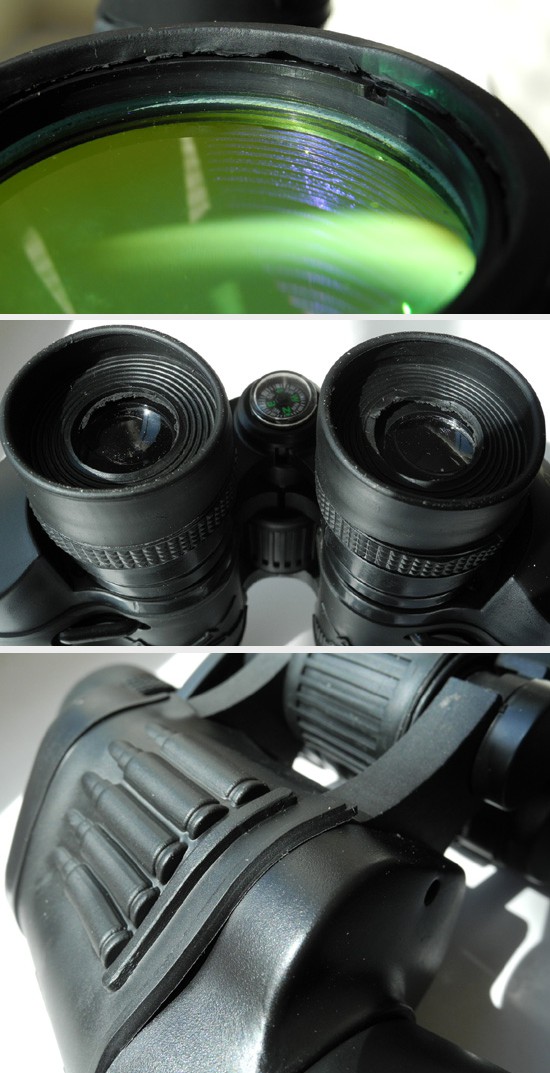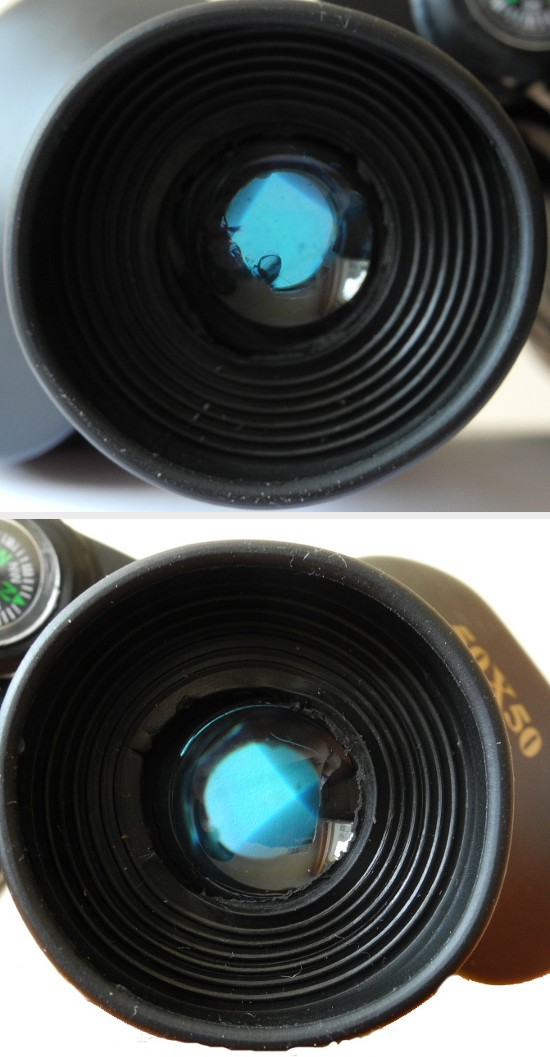Steel ladle 50x50
1. An extreme pair of binoculars
I have dealt with photographic and astronomic optics for over 20 years, I’ve seen a fair share of different equipment, I looked through various instruments, I own many interesting pairs of binoculars and spotting scopes as well. From time to time I am asked for help with a purchase of binoculars or a piece of advice what model to choose. During such conversations I found out that an excellent argument for buying a high quality pair of binoculars is comparing it with something from the very bottom. That’s why I decided to purchase such an instrument – the cheapest possible, not marked by any brand name whatsoever. I found it on a very popular auction site where you can buy any type of shoddy products and fakes, often sold by extremely incompetent salesmen. According to the description provided I purchased an instrument called “’Binoculars Russia 50x50’, proven optics, super hit!” I paid for it a little over 25 PLN (postage and packing included). When the parcel arrived at my place (the binoculars were put in a thin envelope, no security padding whatsoever was added) the first smile appeared on my face as soon as I read the label on the case. You can see that the pair of binoculars, bought by me is, in reality, a “STEEL LADLE MADE IN CHINA” (in Polish "CHOCHLA STALOWA WYPRODUKOWANO W CHINACH”)
Divine decrees are unfathomable - you buy a pair of binoculars you get a ladle |
Please Support UsIf you enjoy our reviews and articles, and you want us to continue our work please, support our website by donating through PayPal. The funds are going to be used for paying our editorial team, renting servers, and equipping our testing studio; only that way we will be able to continue providing you interesting content for free. |
- - - - - - - - - - - - - - - - - - - - - - - - - - - - - - - - - - - - - - - - - - - - - - - -
After opening a surprisingly solid case I found still a pair of binoculars lurking inside but it should rather be called a binoculars-like product. Why? You’ll find out in a moment. I took out the “ladle” out of its case and of course I examined it thoroughly. Here is what I saw.
The objectives are covered by coatings so absurdly intensive that you can’t even glance any Porro prisms through them! No matter at what angle you look everything around is mirrored in the objectives and you can see nothing else. Such coatings make the light transmission extremely low, I would guess on a level of 30-40%. There is also an advantage of such coatings, though. Using such a set of binoculars you can shave without an access to a proper bathroom mirror – what a pity the salesman failed to mention that.
Very intensive coatings on objectives announce bad light transmission results and unnatural colour rendering |
Time for the first observation. I look and I can’t believe it –although I aimed the binoculars at a white wall I see a blue wall! What’s the matter? Perhaps there was a kind of special offer available and I got blue filters the salesman failed to mention? I look the second time and still I can’t believe it…the image is simply blue. You can describe it as slightly blue-ish or with blue dominant. It is nothing more and nothing less but BLUE. ”What a lucky devil I am” , I thought, “I happened to get a limited “Blue Edition” series instrument which allows to simulate observations you can perform otherwise only on Neptune…NASA should have bought one of these…”. After unscrewing one of objectives the colour rendition mystery became solved. In the photo the objective is positioned on the background of a slightly yellow wall.
Blue objectives distort natural colours in a very distinct way. |
Before I progress to optical „properties” let me tell you something about the mechanics. There was a short ribbon attached in a form of a strap to my ladle-binoculars; I am not sure what it is for – it is too short for the case and too narrow for the binoculars themselves. However, if your shoelace, dear Reader, happen to wear through during your holiday trek this “strap” will be an ideal replacement.
The „focusing” mechanism – why put in quotation marks will explained in a moment – is exceptionally imprecise. Even a slight pressure put on an eyecup by pressing it to the area around your eye makes the bridge bend and the focus change. You can even risk a statement that a kind of “focus” can be set by simply pressing the binoculars more or less strongly to your head. When it comes to the rubber padding and finishing, never in my life have I seen such a shoddy workmanship. Just look at the photos.
 The binoculars stand out in a negative way when it comes to the finishing touches. |
The binoculars have an in -built compass with a quite interesting property – it shows you the north whenever you like the north to be, the needle kindly following the movement of the casing. If you happen to get lost in the mountains with such an instrument you won’t be able to find your way either consulting the compass or looking though the binoculars; after some time a Mountain Volunteer Search and Rescue team will find your whitened bones and you will be proclaimed the next victim of Chinese optics, despite the fact that the salesman described it as proven… The shape of exit pupils is a separate topic – as everybody knows very well, they are or rather should be, circular. It is not true for my Blue Edition ladle. The pupils are horribly distorted and indicate, by the way, that the issue of collimation of Porro prisms hasn’t been grasped by the producer yet. Of course it doesn’t mean they can’t continue the production, quite the opposite in fact…
 The shape of the pupils proves bad collimation of the prisms and their damage |
Although the pupils are terribly distorted, which makes any measurement of their size very difficult, at first glance you can tell that the magnification of the binoculars is rather closer to 7x than those 50x, declared by the producer. If it was indeed 50x...I dread to think what you would be able to see through such a wondrous a pair of binoculars.
The shape of the pupils intrigued me so much that I decided to dismantle the binoculars and find out how they look inside. After dismantling (it was quite easy, by the way – the plastic elements were hold together by screws) it turned out that from four Porro prisms only one was not damaged; other three had most of their edges chipped. One of the prisms from the right part is so damaged that about 30% of its surface is simply missing. What’s interesting, after the complete dismantling of the binoculars I didn’t see any glass shards inside. You don’t have to be a Sherlock Holmes to presume that broken prisms are in fact a factory-issued feature, not a result of an accident. Apparently a genius Chinese decided that, instead of paying for recycling of damaged optical elements it is better to simply sold them in a set of binoculars of extreme low quality.
You can clearly notice chipped surface of one of the prisms |
Such prisms are put into binoculars without any brand name... |
To assemble the binoculars not only screws but also some glue was used. In fact they put so much of it that the rear element of the left eyepiece is flooded by it. That’s why nothing is sharp in the left eyepiece– it is also the reason why I put focusing in the quotation marks while describing it above. The image in the right eyepiece is hardly better – despite weak transmission you can notice very low sharpness outside the field of vision centre, high distortion and chromatic aberration. You have to be a lucky devil, getting so many optical aberrations at once in one pair of binoculars.
A layer of glue on the surface of the eyepiece makes it virtually impossible to get any sharp image... |
The optics quality is so low that it seems as much is visible to the naked eye as when you look through the binoculars, of course with the difference that when you observe the world without any help you get natural colours rendition and your head doesn’t ache from bad collimation. You can’t even say that the bad optics quality disturbs the observation; it would be better to say that it is simply impossible to look through this pair of binoculars at all for a longer period of time. When I bought my “steel ladle” I wanted to have a set of binoculars of low quality but nevertheless something you can still call binoculars – an optical instrument which supports my sense of sight. The object I got can only make your eyes tired very quickly and discourage any further observations.
Editors’ Notice
This humorous article, written by Marcin Górko, deals with a very serious problem. Auction sites are simply swamped with cheap binoculars. Perhaps not all of them are as bad as the one described above but almost always such a purchase means wasting your money. Before you buy a cheap pair of binoculars first of all check whether it is listed on the sites of the producer. You can also ask the opinion of more experienced people on different forums.






